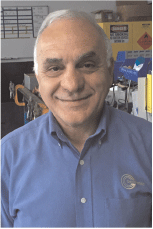Trends in onshore seismic data acquisition: a case study on cable-free nodal systems
Nabeel YassiGeokinetics (Australasia) Pty Ltd.
The APPEA Journal 56(2) 601-601 https://doi.org/10.1071/AJ15107
Published: 2016
Abstract
The desire to conduct onshore seismic surveys without cables has been an elusive dream since the dawn of seismic exploration. Since the late 1970s, seismic surveys were conducted with cabled multi-channels acquisition systems. As the number of channels steadily grew, a fundamental restriction appeared with hundreds of kilometres of line cables dragged on the ground. Seismic surveys within rugged terrain—across rivers, steep cliffs, urban areas, and culturally and environmentally sensitive zones—were both challenging and expansive exercises.
Modern technology has made different cable-free solutions practical. High-resolution analogue to digital converters are now affordable, as are GPS radios for timing and location. Microprocessors and memory are readily available for autonomous recording systems, along with a battery the size and weight of a field nodal now promising to power an acquisition unit for as long as required for normal seismic crew operations.
Many successful 2D and 3D seismic data acquisition using cable-free autonomous nodal systems were attempted in the past few years; however, there remain a number of concerns with these systems.
The first concern queries whether the units are working according to manufacturer specifications during the data acquisition window. The second is the limited or no real-time data quality control that inspires sceptics to use the term blind acquisition to nodal operations. The third is the traditional question of geophone array versus point receiver acquisition. Although a string of the geophone can be connected to autonomous nodes, the preference is to deploy a single or internal geophone with the nodes to maintain the proposed flexibility of cable-free recording systems.
This case study elaborates on the benefits of the cable-free seismic surveys, with specific examples of 2D and 3D exploration programs conducted in Australia in the past few years. Optimisation of field crew size, field crew resources, cost implications, and footprint to the environment, wildlife and domestic livestock will be discussed. In addition, the study focuses on the data quality/data assurance and the processes implanted during data acquisition to maintain equivalent industry standards to cable recording. Emphases will also include data analysis and test results of the geophone array versus the cable-free point receiver recording.

Nabeel Yassi graduated with a BSc (Hons) degree in geology in 1974, a MSc in geophysics in 1977, and a PhD in exploration geophysics in 1984 from the University of Newcastle Upon Tyne (UK). After receiving his PhD, Nabeel worked as an Associate Professor in geophysics at Baghdad University. From the mid 1990s he moved to seismic exploration, and supervised onshore and Transition Zone/OBC seismic data acquisition and data processing for oil and gas exploration, with an extensive track of seismic surveys in Australia, southeast Asia, the Middle East, Africa, and Latin America. Nabeel is now chief geophysicist at Geokinetics (Australasia) Pty Ltd, and his main interests are in optimisation of seismic data acquisition and 2D/3D seismic designs. He advocates the use of nodal seismic recording systems, and is enthusiastic about its performance, data quality, cost efficiency and low impact to the environment. |
References
Ait-Messaoud, M., Boulegroun, M., Gribi, A., Kasmi, R., Touami, M., Anderson, B., Baaren, P., El-Imam, A., Rached, G., Laake, A., Pickering, S., Moldoveanu, N., and Ozbek, A. (2005). New dimensions in land seismic technology. Oilfield Review 17, 42–53.Dean, T., Dupuis, J.C., and Hassan, R., 2014—Field measurements of land seismic Ambient noise and their implications for the effectiveness of geophone arrays, 76 EAGE Conference & Exhibition, Amsterdam, Netherlands, 16–19 June, Tu ELI1 06.
Heath, R. (2015). The Cableless seismic value proposition: where extra caution is required when selecting nodal equipment. Geohorizoins , 14–25.
Pecholcs, P.I., Al-Saad, R., Al-Sannaa, M., Quigley, J., Bagaini, C., Zarkhidze, A., May, R., Guellili, M., Sinanaj, S., and Membrouk, M., 2012—A broadband full azimuth land seismic case study from Saudi Arabia using 100,000 channel recording system at 6 terabyte per day: acquisition and processing lessons learned: 82 Annual Meeting of the SEG, Las Vegas.
Vermeer, G.J.O. 1990 Seismic Wavefield Sampling: A Wave Number Approach to Acquisition Fundamentals. Society of Exploration Geophysicists, Geophysical References Series Volume 4.
Yates, M., and Adiletta, S. (2013). Going nodal – regional 3D seismic acquisition in Cook Inlet, Alaska. The Leading Edge 32, 538–44.


